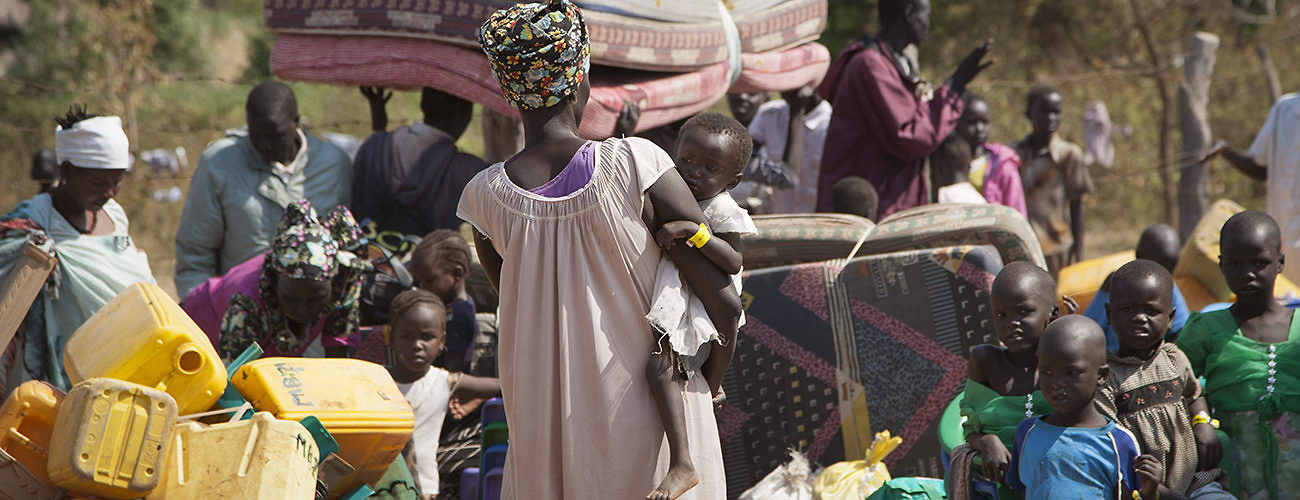Refugees who had fled violence in South Sudan cross into Uganda. Koboko, Uganda, January 6, 2014. (Rebecca Vassie, Associated Press)
“Migration is a mega-trend of the 21st century,” according to William Lacy Swing, Director General of the International Organization for Migration. Roughly 244 million people currently live in countries other than the ones in which they were born, and 65 million are forcibly displaced. On September 19, the United Nations will convene a summit on refugees and migrants to address some of the many issues that stem from these globally significant developments. Although the event has been heavily criticized for the international community’s limited commitments to action until now, the UN convening global leaders on such a timely topic remains a step in the right direction.
This is an extraordinary summit: heads of state will address the large movements of refugees and migrants for the first time in the UN’s history. It will be followed by another high-level meeting solely on refugees convened by several member states and UN Secretary-General Ban Ki-moon on September 20.
These two events should be seen as starting points rather than a destination for global action, however. The international community still needs time to learn how to address the unprecedented wave of human mobility. Migration and asylum claims are often discussed behind closed doors and related policies are considered strictly internal issues. One of the central factors hindering international cooperation is that large movements of people are often conflated with security concerns by states, which invariably results in the tightening of borders.
Currently, there is no global international framework on migration. Each country deals with migrants on an ad hoc basis. This can arguably be said for refugees as well, with the great exception of the 1951 Convention on Refugees that clearly outlines rights under international law. The convention’s principle of “non-refoulement,” which guarantees that individuals cannot be returned “in any manner whatsoever” to places where their life or freedom is threatened, is, however, hanging by a thread, given the number of refugees now detained or redirected to third countries.
The steps taken at the UN summit may begin a new shift on how policies in regards to migrants and refugees are made and implemented. It will make the point that these issues can no longer be treated as an internal or bilateral matter. Moreover, the summit will start to address the current toxic narrative towards migration and refugees. It will highlight the manifold benefits they bring to host communities. As UN Special Representative Peter Sutherland states: “Migration is a crucial dynamic for economic growth.”
A year ago, the attention of the UN was on the adoption of the 2030 Agenda for Sustainable Development, which includes the new global goals (SDGs). The goals were celebrated at the epicenter of international relations in New York—at a summit attended by more than 100 heads of state, along with Pope Francis and prominent celebrities—and elsewhere around the world. Civil society was also incredibly engaged in the process. The 2030 Agenda promises to leave no one—including refugees and migrants—behind.
This year, heads of state will look to adopt the New York Declaration, which contains a number of general commitments that, if implemented, will lead to more humane treatment of refugees and migrants. As a UNHCR spokesperson stated, “The Declaration includes commitments common to refugees and migrants, including: combating exploitation, racism and xenophobia, savings lives en route, as well as ensuring border procedures follow due process and are in line with international law.” The summit should also seek to galvanize support for host countries in dire need of resources to sustain the overflow of people on the move. Developing countries currently host about 86% of refugees under the UN’s mandate.
More concretely, the New York Declaration establishes a route for two processes that will culminate in 2018: the formation of a global compact on refugees and of a global compact for migration. After the summit, these two will have separate tracks.
The one on refugees will be based on a “comprehensive refugee response framework,” with UNHCR taking the lead in crafting a response to each specific refugee situation, ideally even before it reaches the crisis stage. This framework is broader than the traditional refugee response; it will bring in a range of stakeholders from the outset, including local and national authorities, humanitarian and development actors, the private sector, and civil society. By 2018, UNHCR expects to have gathered enough feedback on applying this new framework in different contexts to establish the global compact.
The compact on migration will follow an entirely different process. Since there is no relevant international convention that deals with all dimensions of migration, it will require a long and intense process of negotiation between the 193 UN member states, akin to the negotiation process of the SDGs.
The success or failure of the upcoming summit will not be known on the day of the event or the day after. We will, however, certainly know by 2018 whether it is indeed a game-changer. When attendees left Brazil in 2012 after the Rio+20 Conference on Sustainable Development, little did anyone know that what they had committed to would see the UN adopt the new SDGs three years later. Perhaps we are witnessing another moment of immense opportunity for meeting the needs of migrants and refugees.





